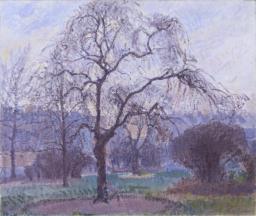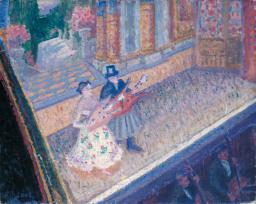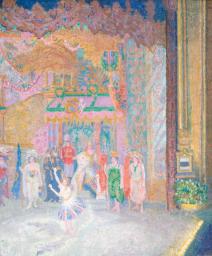Walter Richard Sickert, ‘A Perfect Modern’
The New Age, 9 April 1914, p.718.
A Perfect Modern.
By Walter Sickert.
It will perhaps be convenient and appropriate for me to postpone taking up the thread of my considerations on scale till next week, and to endeavour to concentrate in a page some of the reflections suggested by the short life of one of our greatest modern painters, the unfolding of whose genius it has been my privilege to watch from a position of exceptional advantage.
Spencer Frederick Gore built his astonishingly accelerated and fragrantly personal development on the good and stable foundation of a faithful, reverent and obedient studentship. It was at the end of that studentship that I first made his acquaintance. If he learnt to command, and, the years that are to come will amply justify my opinion that his influence on a whole generation has only begun, it was that he had been content to obey for many years in silence. Monsieur Degas once sketched out to me an ideal which he had always sighed for. He said, “I wish things were so that when I was asked, ‘Why do you do this or that,’ I might answer ‘Because my master told me to.’ ” It was curious, in these days, and distinctly unfashionable to hear a young man, who was already influencing a whole generation, willingly allude with gratitude and appreciation to the authority of the men under whom he studied. It was a common thing for him to recall with pleasure the excellence and rightness of this or that piece of advice or example that he owed individually to each of his teachers. “Brown,” he would say, “taught me such a thing very thoroughly.” “Steer was right when he insisted on this, or Tonks on that.” “Russell’s practice was always thus.” And this power of glad and grateful assimilation remained his throughout the short years into which he crowded the sane experiences and ordered achievements that are given to few men of long life to accumulate.
If leisure for reflection, musing, a kind of playing chess with ideas, may he said to be the ultimate aim for which we all grunt and sweat, and, as the French say, derange ourselves, it was Gore’s secret that he wrung, out of a life of incessant intellectual and material service to colleagues and friends, seemingly twenty-four hours a day for the exercise of the purest, the serenest, and the most exhilarated reflection. But it was brush in hand that he reflected.
How conscious most painters are all their lives of this difficulty. They can truly claim, perhaps, to have wielded their pick and spade with energy during the appointed hours, but the magic moments seem always to find them unarmed. Either it is too early in the day, and their wits are not yet with them, or it is too late and they have laid down their tools. The most magnificent game seem always to be started when they have not their gun handy. It was Gore’s secret that he seemed to have bagged his bird before or after hours, without prejudice to the regular day’s work.
The causes for this faculty, or, let us say, habit, are not far to seek. His intelligence must have told him early that the material paraphernalia of painting is a truculent and hard-mouthed beast. But it was the one he intended to ride, and he took care to come to terms with it from the first, or rather that it came to terms with him – his terms. He had the hardness, with himself, that belongs to breeding, or genius, or both. I never heard him complain of anything. His view of the function of a modern realist in painting can be clearly deduced from his practice. Firstly, he was to accomplish his purpose by means of his chosen instrument, which was oil-paint. He cultivated this instrument to such purpose, that, though he proposed, in time, to fit in campaigns in other fields, and would doubtless have done so had he lived, it would be exact to say of him, as one says of a musician, “he was a violinist,” “he was a pianist,” that he was an oil-painter. He accepted the instrument as he found it handed down to us by Monet and Pissarro, let us say, for brevity. He accepted it for what is to be got out of it as an opaque mosaic. He held the not unreasonable conviction that nature was a thicker lexicon than what was bound between the covers of any one human being, and he drilled himself to be the passive and enchanted conduit for whatever of loveliness his eyes might rest upon.
He became a great draughtsman by the road of colour. His studies in line for the extremely complicated pictures he painted of music-hall scenes were means to an end, and therefore so concise as not to be easily legible to a layman. For this very reason, devoid of rhetoric and padding as they are, they will be valued as educational documents of importance. I shall always remember my envy at the dogged way in which he would take his stand, in all weathers, in the queue at the door of the Alhambra at an impossibly early hour, with the regularity of clockwork, so that he might find himself in the desired seat to continue his study of some chosen scene. Some of these pictures were miracles of charm, and above all of fullness. Conder-like fancies, they had the resonance of reality, with all their grace as firmly established in its three dimensions as sculpture. I can see ballets like forests of seaweed extended like fans under an immense arch of some capricious border of coloured darkness. I remember a drop-scene, pregnant behind its coloured vignette of some magical nonsense to come, with, before it, the stiff and apologetic movement silhouetted of a group of late arrivals making their way through the stalls. One picture represents the burlesque apotheosis of the end of an act where there are kings, and “principal boys,” and officers in uniform and, conspicuously draped, a Union Jack which plays the leading rôle in the impression.
I remember a garden of rose-trees, little stiff trees aligned with bare thin stems, planted like a set of skittles, or soldiers in extended formation, each one with its tender and radiant burden, trembling in the glittering sunlight. I remember their shadows and the gravel path beyond seen through the stems, and that the path dipped under the shade of some branches, under which was the way out from the picture to some promise of more. Gore understood very well that the painter can give only a sample of each kind of nature, can only make of each canvas a microcosm of each mansion in the house of life.
There was a month of June a few years ago which Gore verily seems to have used as if he had known that it was to be for him the last of its particularly fresh and sumptuous kind. He used it to look down on the garden of Mornington Crescent. The trained trees rise and droop in fringes, like fountains, over the little well of greenness and shade where little parties of young people are playing at tennis. The back-cloth of this scene is formed by the tops of the brown houses of the Hampstead Road, and the liver-coloured tiles of the Tube Station.
But it is not only out of scenes obviously beautiful in themselves, and of delightful suggestion, that the modern painter can conjure a panel of encrusted enamel. Gore had the digestion of an ostrich. A scene, the dreariness and hopelessness of which would strike terror into most of us, was to him matter for lyrical and exhilarated improvisation. I have a picture by him of a place that looks like hell, with a distant iron bridge in the middle distance, and a bad classic façade like the façade of a kinema, and two new municipal trees like brooms, and the stiff curve of a new pavement in front, on which stalks and looms a lout in a lounge suit. The artist is he who can take a piece of flint and wring out of it drops of attar of roses.
The memorial exhibition will give us the opportunity of realising what a decade of maturity can accomplish in the hands of genius. Our critics are voluble in prophecy about the art of the future. It is more probable that the future will belong to those who have accomplished something in the present, than to the young men who sit in the Café Royal waiting to be crowned on the strength of their own post-dated stumers on futurity.
© Estate of Walter R. Sickert
How to cite
Walter Richard Sickert, ‘A Perfect Modern’, in The New Age, 9 April 1914, p.718, in Helena Bonett, Ysanne Holt, Jennifer Mundy (eds.), The Camden Town Group in Context, Tate Research Publication, May 2012, https://www



